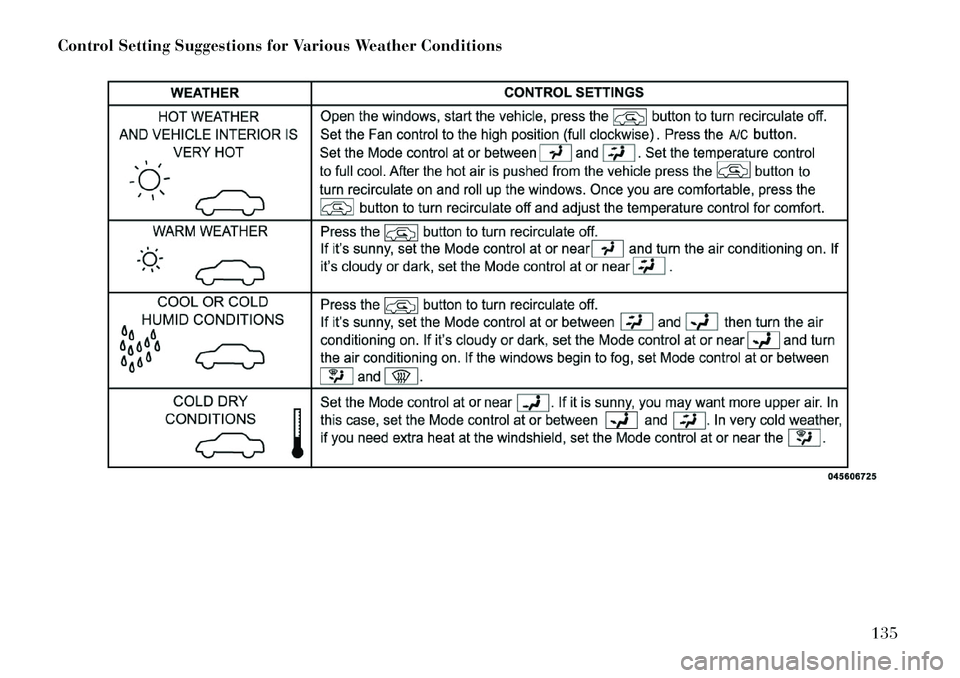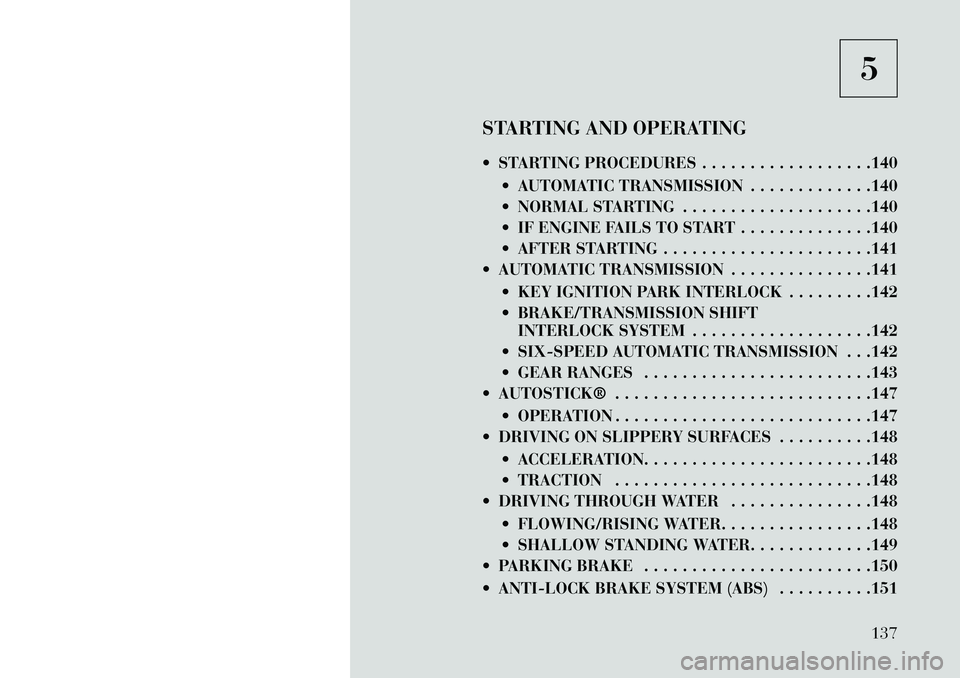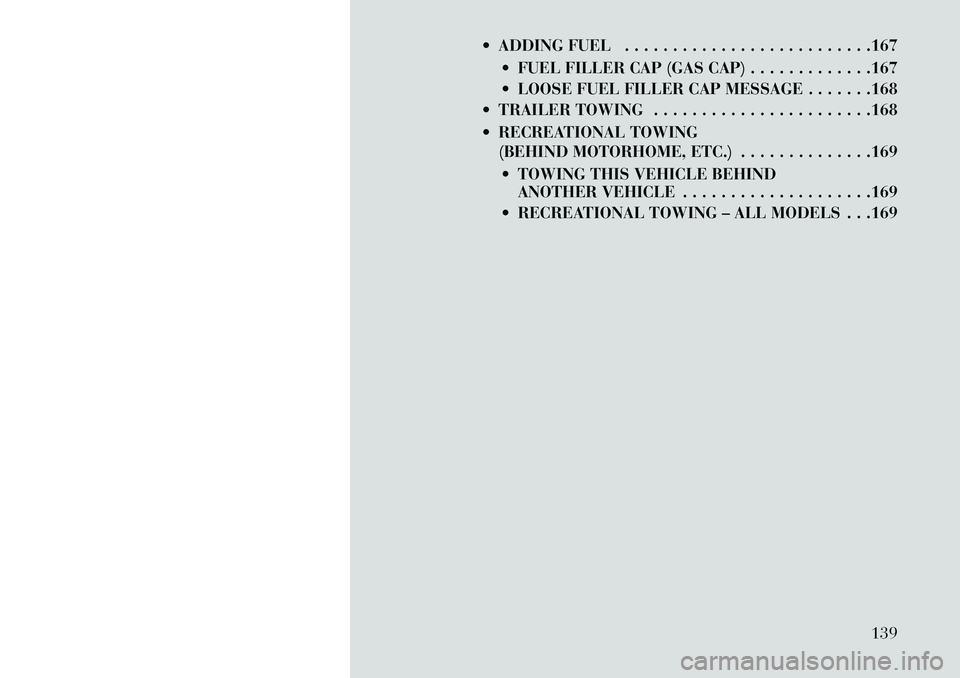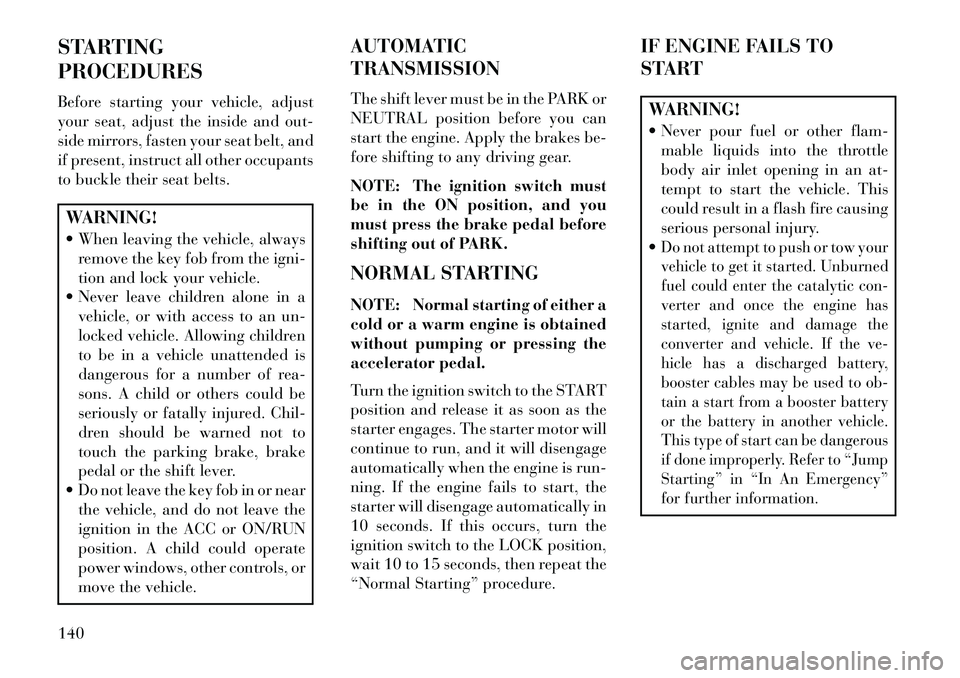Lancia Flavia 2013 Owner handbook (in English)
Manufacturer: LANCIA, Model Year: 2013, Model line: Flavia, Model: Lancia Flavia 2013Pages: 244, PDF Size: 2.87 MB
Page 141 of 244

Control Setting Suggestions for Various Weather Conditions
135
Page 142 of 244

Outside Air Intake
Make sure the air intake, located di-
rectly in front of the windshield, is
free of obstructions such as leaves.
Leaves collected in the air intake may
reduce airflow, and if they enter the
plenum, they could plug the water
drains. In winter months, make sure
the air intake is clear of ice, slush, and
snow.
A/C Air Filter
The A/C Filter prevents most dust
and pollen from entering the cabin.
The filter acts on air coming from
outside the vehicle and recirculated
air within the passenger compart-
ment. Refer to “Maintenance Proce-
dures” in “Maintaining Your Vehicle”
for A/C Air Filter service information
or see your authorized dealer for ser-
vice. Refer to “Maintenance Sched-
ules” for filter service intervals.
136
Page 143 of 244

5
STARTING AND OPERATING
STARTING PROCEDURES . . . . . . . . . . . . . . . . . .140 AUTOMATIC TRANSMISSION . . . . . . . . . . . . .140
NORMAL STARTING . . . . . . . . . . . . . . . . . . . .140
IF ENGINE FAILS TO START . . . . . . . . . . . . . .140
AFTER STARTING . . . . . . . . . . . . . . . . . . . . . .141
AUTOMATIC TRANSMISSION . . . . . . . . . . . . . . .141
KEY IGNITION PARK INTERLOCK . . . . . . . . .142
BRAKE/TRANSMISSION SHIFTINTERLOCK SYSTEM . . . . . . . . . . . . . . . . . . .142
SIX-SPEED AUTOMATIC TRANSMISSION . . .142
GEAR RANGES . . . . . . . . . . . . . . . . . . . . . . . .143
AUTOSTICK® . . . . . . . . . . . . . . . . . . . . . . . . . . .147
OPERATION . . . . . . . . . . . . . . . . . . . . . . . . . . .147
DRIVING ON SLIPPERY SURFACES . . . . . . . . . .148
ACCELERATION. . . . . . . . . . . . . . . . . . . . . . . .148
TRACTION . . . . . . . . . . . . . . . . . . . . . . . . . . .148
DRIVING THROUGH WATER . . . . . . . . . . . . . . .148
FLOWING/RISING WATER. . . . . . . . . . . . . . . .148
SHALLOW STANDING WATER. . . . . . . . . . . . .149
PARKING BRAKE . . . . . . . . . . . . . . . . . . . . . . . .150
ANTI-LOCK BRAKE SYSTEM (ABS) . . . . . . . . . .151
137
Page 144 of 244

POWER STEERING . . . . . . . . . . . . . . . . . . . . . . .152 POWER STEERING FLUID CHECK . . . . . . . . .153
ELECTRONIC BRAKE CONTROL SYSTEM . . . . .153
ANTI-LOCK BRAKE SYSTEM (ABS) . . . . . . . . .154
TRACTION CONTROL SYSTEM (TCS) . . . . . . .154
BRAKE ASSIST SYSTEM (BAS) . . . . . . . . . . . .154
ELECTRONIC STABILITY CONTROL (ESC) . .154
ESC ACTIVATION/MALFUNCTION INDICATORLIGHT AND ESC OFF INDICATOR LIGHT . . . .156
TIRES — GENERAL INFORMATION . . . . . . . . . .157
TIRE PRESSURE . . . . . . . . . . . . . . . . . . . . . . .157
TIRE INFLATION PRESSURES . . . . . . . . . . . .157
RADIAL-PLY TIRES . . . . . . . . . . . . . . . . . . . . .158
TIRE SPINNING . . . . . . . . . . . . . . . . . . . . . . . .159
TREAD WEAR INDICATORS . . . . . . . . . . . . . .159
LIFE OF TIRE . . . . . . . . . . . . . . . . . . . . . . . . .159
REPLACEMENT TIRES . . . . . . . . . . . . . . . . . .160
TIRE CHAINS . . . . . . . . . . . . . . . . . . . . . . . . . . .160
TIRE ROTATION RECOMMENDATIONS . . . . . . .161
TIRE PRESSURE MONITOR SYSTEM (TPMS) . .161
PREMIUM SYSTEM . . . . . . . . . . . . . . . . . . . . .163
FUEL REQUIREMENTS . . . . . . . . . . . . . . . . . . . .164
METHANOL . . . . . . . . . . . . . . . . . . . . . . . . . .165
ETHANOL . . . . . . . . . . . . . . . . . . . . . . . . . . . .165
CLEAN AIR GASOLINE . . . . . . . . . . . . . . . . . .165
MMT IN GASOLINE . . . . . . . . . . . . . . . . . . . . .166
MATERIALS ADDED TO FUEL . . . . . . . . . . . .166
138
Page 145 of 244

ADDING FUEL . . . . . . . . . . . . . . . . . . . . . . . . . .167 FUEL FILLER CAP (GAS CAP) . . . . . . . . . . . . .167
LOOSE FUEL FILLER CAP MESSAGE . . . . . . .168
TRAILER TOWING . . . . . . . . . . . . . . . . . . . . . . .168
RECREATIONAL TOWING (BEHIND MOTORHOME, ETC.) . . . . . . . . . . . . . .169
TOWING THIS VEHICLE BEHIND ANOTHER VEHICLE . . . . . . . . . . . . . . . . . . . .169
RECREATIONAL TOWING – ALL MODELS . . .169
139
Page 146 of 244

STARTING
PROCEDURES
Before starting your vehicle, adjust
your seat, adjust the inside and out-
side mirrors, fasten your seat belt, and
if present, instruct all other occupants
to buckle their seat belts.WARNING!
When leaving the vehicle, alwaysremove the key fob from the igni-
tion and lock your vehicle.
Never leave children alone in a vehicle, or with access to an un-
locked vehicle. Allowing children
to be in a vehicle unattended is
dangerous for a number of rea-
sons. A child or others could be
seriously or fatally injured. Chil-
dren should be warned not to
touch the parking brake, brake
pedal or the shift lever.
Do not leave the key fob in or near the vehicle, and do not leave the
ignition in the ACC or ON/RUN
position. A child could operate
power windows, other controls, or
move the vehicle. AUTOMATIC
TRANSMISSION
The shift lever must be in the PARK or
NEUTRAL position before you can
start the engine. Apply the brakes be-
fore shifting to any driving gear.
NOTE: The ignition switch must
be in the ON position, and you
must press the brake pedal before
shifting out of PARK.
NORMAL STARTING
NOTE: Normal starting of either a
cold or a warm engine is obtained
without pumping or pressing the
accelerator pedal.
Turn the ignition switch to the START
position and release it as soon as the
starter engages. The starter motor will
continue to run, and it will disengage
automatically when the engine is run-
ning. If the engine fails to start, the
starter will disengage automatically in
10 seconds. If this occurs, turn the
ignition switch to the LOCK position,
wait 10 to 15 seconds, then repeat the
“Normal Starting” procedure.
IF ENGINE FAILS TO
START
WARNING!
Never pour fuel or other flam-
mable liquids into the throttle
body air inlet opening in an at-
tempt to start the vehicle. This
could result in a flash fire causing
serious personal injury.
Do not attempt to push or tow your
vehicle to get it started. Unburned
fuel could enter the catalytic con-
verter and once the engine has
started, ignite and damage the
converter and vehicle. If the ve-
hicle has a discharged battery,
booster cables may be used to ob-
tain a start from a booster battery
or the battery in another vehicle.
This type of start can be dangerous
if done improperly. Refer to “Jump
Starting” in “In An Emergency”
for further information.
140
Page 147 of 244

If the engine fails to start after you have
followed the “Normal Starting” proce-
dure, it may be flooded. To clear any
excess fuel, push the accelerator pedal
all the way to the floor and hold it.
Then, turn the ignition switch to the
START position and release it as soon as
the starter engages. The starter motor
will disengage automatically in 10 sec-
onds. Once this occurs, release the
accelerator pedal, turn the ignition
switch to the LOCK position, wait 10 to
15 seconds, then repeat the “Normal
Starting” procedure.CAUTION!
To prevent damage to the starter,
wait 10 to 15 seconds before trying
again.
AFTER STARTING
The idle speed will automatically de-
crease as the engine warms up. AUTOMATIC
TRANSMISSION
CAUTION!
Damage to the transmission may
occur if the following precautions
are not observed:
Shift into PARK only after the ve-
hicle has come to a complete stop. Shift into or out of REVERSE
only after the vehicle has come to
a complete stop and the engine is
at idle speed.
Do not shift between PARK, RE-
VERSE, NEUTRAL, or DRIVE
when the engine is above idle
speed.
Before shifting into any gear,
make sure your foot is firmly
pressing on the brake pedal.
NOTE: You MUST press and hold
the brake pedal while shifting out
of PARK.
WARNING!
It is dangerous to shift out of PARK or NEUTRAL if the engine
speed is higher than idle speed. If
your foot is not firmly pressing on
the brake pedal, the vehicle could
accelerate quickly forward or in
reverse. You could lose control of
the vehicle and hit someone or
something. Only shift into gear
when the engine is idling nor-
mally and your foot is firmly
pressing on the brake pedal.
Unintended movement of a ve- hicle could injure those in and
near the vehicle. As with all ve-
hicles, you should never exit a
vehicle while the engine is run-
ning. Before exiting a vehicle, al-
ways apply the parking brake,
shift the transmission into PARK,
turn the engine OFF, and remove
the ignition key. When the igni-
tion is in the OFF position, the
shift lever is locked in PARK, se-
curing the vehicle against un-
wanted movement. Furthermore,
(Continued)
141
Page 148 of 244

WARNING!(Continued)
you should never leave children
alone in a vehicle, or with access
to an unlocked vehicle. Allowing
children to be in a vehicle unat-
tended is dangerous for a number
of reasons. A child or others could
be seriously or fatally injured.
Children should be warned not to
touch the parking brake, brake
pedal or the shift lever.
Do not leave the key fob in or near the vehicle, and do not leave a
vehicle equipped with Keyless
Enter-N-Go in the ACC or ON/
RUN position. A child could oper-
ate power windows, other con-
trols, or move the vehicle. KEY IGNITION PARK
INTERLOCK
This vehicle is equipped with a Key
Ignition Park Interlock which requires
the shift lever to be placed in PARK
before the ignition switch can be turned
to the LOCK/OFF position. The key fob
can only be removed from the ignition
when the ignition is in the LOCK/OFF
position and once removed the shift
lever is locked in PARK.NOTE: If a malfunction occurs,
the system will trap the key in the
ignition switch to warn you that
this safety feature is inoperable.
The engine can be started and
stopped, but the key cannot be re-
moved until you obtain service.
BRAKE/TRANSMISSION
SHIFT INTERLOCK
SYSTEM
This vehicle is equipped with a Brake
Transmission Shift Interlock System
(BTSI) that holds the shift lever in
PARK unless the brakes are applied. To move the shift lever out of PARK,
the ignition switch must be turned to
the ON/RUN position (engine run-
ning or not) and the brake pedal must
be pressed.
SIX-SPEED AUTOMATIC
TRANSMISSION
The shift lever position display (lo-
cated in the instrument cluster) indi-
cates the transmission gear range. You
must press the brake pedal to move
the shift lever out of PARK (refer to
“Brake/Transmission Shift Interlock
System” in this section). To drive,
move the shift lever from PARK or
NEUTRAL to the DRIVE position.
The electronically-controlled transmis-
sion provides a precise shift schedule.
The transmission electronics are self-
calibrating; therefore, the first few shifts
on a new vehicle may be somewhat
abrupt. This is a normal condition, and
precision shifts will develop within a
few hundred kilometers.
Shift Lever
142
Page 149 of 244

Only shift from DRIVE to PARK or
REVERSE when the accelerator
pedal is released and the vehicle is
stopped. Be sure to keep your foot on
the brake pedal when shifting be-
tween these gears.The transmission shift lever has PARK,
REVERSE, NEUTRAL, DRIVE, and
AutoStick® shift positions. Manual
shifts can be made using the
AutoStick® shift control (refer to
“AutoStick®” in “Starting And Operat-
ing” for further information). Moving
the shift lever to the left or right (-/+)
while in the AutoStick® position (below
the Drive position) will manually select
the transmission gear, and will display
the current gear in the instrument clus-
ter as 6, 5, 4, 3, 2, 1.GEAR RANGES
DO NOT race the engine when shift-
ing from PARK or NEUTRAL into
another gear range.NOTE: After selecting any gear
range, wait a moment to allow the
selected gear to engage before ac-
celerating. This is especially im-
portant when the engine is cold.
PARK
This range supplements the parking
brake by locking the transmission.
The engine can be started in this
range. Never attempt to use PARK
while the vehicle is in motion. Apply
the parking brake when leaving the
vehicle in this range.
When parking on a level surface, you
may place the shift lever in PARK first,
and then apply the parking brake.When parking on a hill, apply the
parking brake before placing the shift
lever in PARK, otherwise the load on
the transmission locking mechanism
may make it difficult to move the shift
lever out of PARK. As an added pre-
caution, turn the front wheels toward
the curb on a downhill grade and
away from the curb on an uphill
grade.
WARNING!
Never use the PARK position as a
substitute for the parking brake.
Always apply the parking brake
fully when parked to guard
against vehicle movement and
possible injury or damage.
Your vehicle could move and injure
you and others if it is not com-
pletely in PARK. Check by trying to
move the shift lever rearward (with
the brake pedal released) after you
have placed it in PARK. Make sure
the transmission is in PARK before
leaving the vehicle. It is dangerous to move the shift lever out of PARK or NEUTRAL
if the engine speed is higher than
idle speed. If your foot is not
firmly pressing on the brake
pedal, the vehicle could acceler-
ate quickly forward or in reverse.
You could lose control of the ve-
hicle and hit someone or some-
thing. Only shift into gear when
the engine is idling normally and
your foot is firmly pressing the
brake pedal.
(Continued)
143
Page 150 of 244

WARNING!(Continued)
Unintended movement of a ve- hicle could injure those in or near
the vehicle. As with all vehicles,
you should never exit a vehicle
while the engine is running. Be-
fore exiting a vehicle, always ap-
ply the parking brake, shift the
transmission into PARK, and re-
move the ignition key. Once the
key is removed, the shift lever is
locked in the PARK position, se-
curing the vehicle against un-
wanted movement.
When leaving the vehicle, always remove the key fob and lock your
vehicle.
Never leave children alone in a vehicle, or with access to an un-
locked vehicle. Allowing children
to be in a vehicle unattended is
dangerous for a number of rea-
sons. A child or others could be
seriously or fatally injured. Chil-
dren should be warned not to
touch the parking brake, brake
pedal or the shift lever.
(Continued)
WARNING!(Continued)
Do not leave the key fob in or near the vehicle, and do not leave the
ignition in the ACC or ON/RUN
position. A child could operate
power windows, other controls, or
move the vehicle.CAUTION!
Before moving the shift lever out
of PARK, you must turn the igni-
tion switch from the LOCK/OFF
position to the ON/RUN position,
and also press the brake pedal.
Otherwise, damage to the shift le-
ver could result. DO NOT race the engine whenshifting from PARK or NEU-
TRAL into another gear range, as
this can damage the drivetrain.
The following indicators should be
used to ensure that you have engaged
the shift lever into the PARK position:
When shifting into PARK, firmly move the shift lever all the way
forward and to the left until it stops
and is fully seated. Look at the shift lever position dis-
play and verify that it indicates the
PARK position.
With brake pedal released, verify that the shift lever will not move out
of PARK.
REVERSE
This range is for moving the vehicle
backward. Shift into REVERSE only
after the vehicle has come to a com-
plete stop.
NEUTRAL
Use this range when the vehicle is
standing for prolonged periods with
the engine running. The engine may
be started in this range. Apply the
parking brake and shift the transmis-
sion into PARK if you must leave the
vehicle.
144